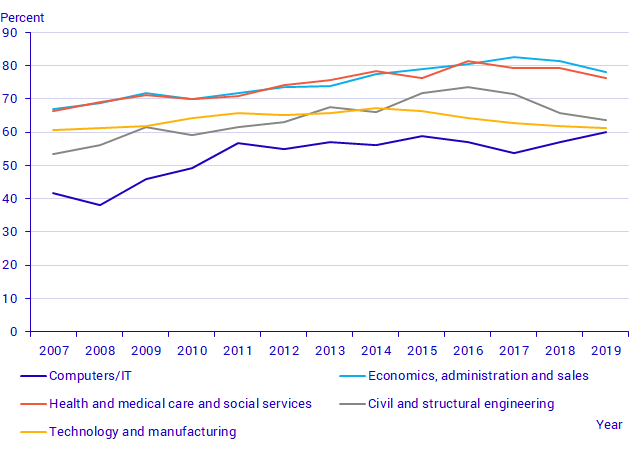Graduates of higher vocational education studies in 2019
More graduates from higher vocational education in 2019
Statistical news from Statistics Sweden 2020-11-25 9.30
The proportion of graduates of higher vocational programmes in 2019 increased by seven percent compared with the previous year, although the rate of graduation decreased somewhat among both women and men. More women than men continue to graduate from higher vocational programmes.
In 2019, there were 14 500 graduates from higher vocational programmes, which is 1 000 more than in 2018. The number of women increased the most, by just over 700. Among graduates, the proportion of women, which has been larger over time than the proportion of men, was now 59 percent.

The increase in 2011 is mainly because programmes in addition to the ordinary application process were granted. The increase in 2015 is explained largely by a sharp rise in the volume of admitted students who completed their education in 2015.
Major differences between the sexes persist in different fields of education
Economics and business studies was the field of education with the highest number of graduates, 4 100, of whom women accounted for 78 percent. This was followed by health and medical care and social services, with 2 200 graduates, of whom 91 percent were women. In engineering and manufacturing and civil and structural engineering, which had 1 700 graduates and 1 800 graduates respectively, there were predominantly men, who accounted for 78 percent and 72 percent respectively.

The rate of graduation was lower in 2019
The total rate of graduation was 71 percent in 2019, compared with 72 percent in 2018.
The rate of graduation among women fell from 78 percent to 76 percent, while the rate of graduation among men fell from 66 percent to 65 percent. There are also major differences between fields of education.
Among the five largest fields of education, the highest rate of graduation, 78 percent, continues to be noted in the field of economics and business studies. The lowest rate of graduation in the five largest fields of education, 60 percent, was noted in computers/IT. However, there was an increase in computers/IT compared with the previous year.

Distance learning programmes increasing, but with a lower rate of graduation
The proportion of graduates of distance learning programmes increased from 19 percent to 20 percent. In 2019, the rate of graduation in distance learning programmes was 61 percent. The corresponding figure for traditional programmes was 74 percent.

Rate of graduation was highest among women with a Swedish background
The highest rate of graduation, 79 percent, was among women with a Swedish background, while the lowest rate of graduation, 55 percent, was among men with a foreign background. The rate of graduation among women with a foreign background and among men with a Swedish background was 68 percent and 69 percent respectively.

Definitions and explanations
Official statistics on higher vocational education
Since 2018, Statistics Sweden has been responsible for official statistics on higher vocational education. Statistics on graduates in higher vocational education are based on information from the Swedish National Agency for Higher Vocational Education, which in turn receives the information from the education providers.
Graduates
Graduates refers to all those who graduated from a programme session. Graduates are reported based on the final year of the programme, rather than the date on which the student actually graduated. Late additions lead to some lag in the statistics, and around 100 graduates are estimated to be added in the next publication in November 2021.
Rate of graduation
The rate of graduation refers to the proportion of graduates in percent who conducted studies at programmes that lead to a qualification. Late additions affect the rate of graduation.
Each programme session counts
Persons who have been active students in several programmes during a specific period are counted once for each programme session. In 2019, just over 200 persons commenced their studies in more than one programme session. Roughly 20 people received more than one qualification in 2019.
Field of education
Field of education refers to the classification of programmes in the fields of education used by the Swedish National Agency for Higher Vocational Education (MYH). The fields of education are based on the SUN 2020 standard.
Next publishing will be
Statistics on students and graduates in 2020 will be published in March 2021. Detailed statistics on graduates in 2020 will be published in November 2021.
Statistical Database
More information is available in the Statistical Database
Feel free to use the facts from this statistical news but remember to state Source: Statistics Sweden.
